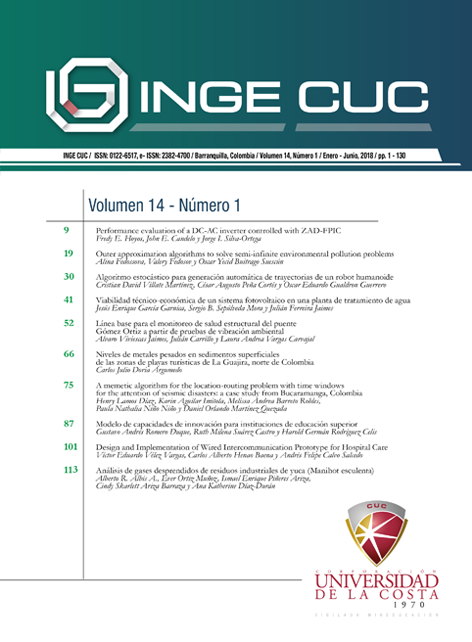Performance evaluation of a DC-AC inverter controlled with ZAD-FPIC
DOI:
https://doi.org/10.17981/ingecuc.14.1.2018.01Keywords:
Control of power converters, ZAD-FPIC technique, DC-AC converterAbstract
Introduction: Power converters are used in microgrids to transfer power to the load with a regulated voltage. However, the DC-AC converters present distortions in the waveform that can be improved with the help of real-time controllers.
Objective: Evaluate the response in alternating current of the buck converter controlled using ZAD-FPIC technique.
Methodology: Based on the differential equations that describe the buck power converter, the ZAD and FPIC controllers are designed, simulations of the complete controlled system are made in Simulink of MATLAB, the system is implemented experimentally, and the controller is executed in real-time with the help of a DS1104 from dSPACE. In the end, several tests are carried out to check the effectiveness of the controller.
Results: The results show that the controller allows good stability against different variations in the system and in the load.
Conclusions: The ZAD-FPIC technique controls the variable and tracks changes in the waveform, magnitude, and frequency of the reference signal. The controller presents good stability to different tests, tracking the reference signal after each event.
Downloads
References
[2] A. Ospino-Castro, “Análisis del potencial energético solar en la Región Caribe para el diseño de un sistema fotovoltaico,” INGECUC, vol. 6, no. 6, pp. 95-102, 2010.
[3] P. A. Andrade, J. L. Morejon and E. M. Inga, “Cobertura Máxima de Redes de Sensores Inalámbricos para un Sistema de Gestión de Energía en Hogares Inteligentes. Maximum Coverage of Wireless Sensor Networks for an Energy Management System in Smart Homes,” INGECUC, vol. 12, no. 2, pp. 68–78, 2016. http://dx.doi.org/10.17981/ingecuc.12.2.2016.07
[4] D. W. Hart, Electrónica de potencia, Madrid: Prentice Hall-Pearson Educación, 2001.
[5] N. Mohan, Advanced Electric Drives: Analysis, Control, and Modeling Using MATLAB / Simulink. John Wiley & Sons, 2014, 208 p. https://doi.org/10.1002/9781118910962
[6] M. Rashid, Power Electronics Handbook, Third Edition, Butterworth-Heinemann, 2010, 1362 p., p. 249- 264.
[7] J. L. Strack, J. A. Suárez, G. F. Di Mauro and S. B. Jacob, “Impacto de la iluminación residencial eficiente en la calidad de la energía de una red de distribución” INGE CUC, vol. 10, no. 2, pp. 9-19, Dec. 2014.
[8] E. Fossas, R. Griñó and D. Biel, “Quasi-Sliding control based on pulse width modulation, zero averaged dynamics and the L2 norm,” Advances in Variable Structure Systems - 6th IEEE International Workshop on Variable Structure Systems, pp. 335–344, 2000. https://doi.org/10.1142/9789812792082_0031
[9] R. R. Ramos, D. Biel, E. Fossas and F. Guinjoan, “A fixed-frequency quasi-sliding control algorithm: application to power inverters design by means of FPGA implementation,” IEEE Trans. Power Electron., vol. 18, no. 1, pp. 344–355, Jan. 2003. https://doi.org/10.1109/TPEL.2002.807164
[10] F. Angulo, G. Olivar and M. di Bernardo, “Two-Parameter Discontinuity-Induced Bifurcation Curves in a ZAD-Strategy-Controlled DC–DC Buck Converter”, IEEE Transactions on Circuits and Systems, vol 55, no. 08, pp. 2392 – 2401, 2008. ISBN: 1549-8328. https://doi.org/10.1109/TCSI.2008.918226
[11] F. E. Hoyos, N. Toro and Y. A. Garcés, “Adaptive Control for Buck Power Converter Using Fixed Point Inducting Control and Zero Average Dynamics Strategies,” Int. J. Bifurcation. Chaos, vol. 25, no. 4, pp. 1550049-150061, Apr. 2015. https://doi.org/10.1142/S0218127415500492
[12] J. Taborda, D. Burbano and F. Angulo, “Quantization Effects on Period Doubling Route to Chaos in a ZAD Controlled Buck Converter”, Mathematical Problems in Engineering, vol 2012, pp. 1-19, 2012. https://doi.org/10.1155/2012/526394
[13] A. EL Aroudi, F. Angulo, G. Olivar, B. G. M. Robert and M. Feki, “Stabilizing a two-cell dc-dc buck converter by fixed point induced control,” International Journal of Bifurcation and Chaos, 2009, vol 19, no. 06, pp. 2043-2057, 2009. https://doi.org/10.1142/S0218127409023895
[14] J. Muñoz, G. Osorio, and F. Angulo, “Boost converter control with ZAD for power factor correction based on FPGA”, Workshop on, Power Electronics and Power Quality Applications (PEPQA), pp. 1–5, 2013. https://doi.org/10.1109/PEPQA.2013.6614942
[15] F. E. Hoyos, D. Burbano, F. Angulo, G. Olivar, N. Toro and J. A. Taborda, “Effects of quantization, delay and internal resistances in digitally ZAD-controlled buck converter,” Int. J. Bifurcation and Chaos, vol. 22, no. 10, pp. 1250245, Oct. 2012. https://doi.org/10.1142/S0218127412502458
[16] P. Deivasundari, G. Uma and S. Ashita, “Chaotic dynamics of a zero average dynamics controlled DC–DC Ćuk converter,” IET Power Electron., vol. 7, no. 2, pp. 289–298, Feb. 2014. https://doi.org/10.1049/iet-pel.2012.0737
[17] F. Angulo, G. Olivar, J. Taborda, and F.E Hoyos, “Nonsmooth dynamics and FPIC chaos control in a DC-DC ZAD-strategy power converter,” in ENOC, pp. 1–6, 2008.
[18] F. Angulo, “Análisis de la dinámica de convertidores electrónicos de potencia usando PWM basado en promediado cero de la dinámica del error (ZAD),” Universidad Politécnica de Cataluña, 2004.
[19] F. Angulo, J. E. Burgos, and G. Olivar, “Chaos stabilization with TDAS and FPIC in a buck converter controlled by lateral PWM and ZAD,” in 2007 Mediterranean Conference on Control & Automation, pp. 1–6, Jun. 2007. https://doi.org/10.1109/MED.2007.4433846
[20] J. A. Taborda, S. Santini, M. di Bernardo, and F. Angulo, “Active Chaos Control of a Cam-Follower Impacting System using FPIC Technique,” IFAC Proc. vol. 42, no. 7, pp. 327–332, 2009. https://doi.org/10.3182/20090622-3-UK-3004.00061
[21] F. E. Hoyos Velasco, C. Younes Velosa, and E. A. Cano Plata, “Técnicas de filtrado de IEM en convertidores electrónicos de potencia,” Ing. e Investig., vol. 30, no. 2, pp. 168–177, 2010.
Downloads
Published
How to Cite
Issue
Section
License
Published papers are the exclusive responsibility of their authors and do not necessary reflect the opinions of the editorial committee.
INGE CUC Journal respects the moral rights of its authors, whom must cede the editorial committee the patrimonial rights of the published material. In turn, the authors inform that the current work is unpublished and has not been previously published.
All articles are licensed under a Creative Commons Attribution-NonCommercial-NoDerivatives 4.0 International License.



 English
English
 Español (España)
Español (España)






















